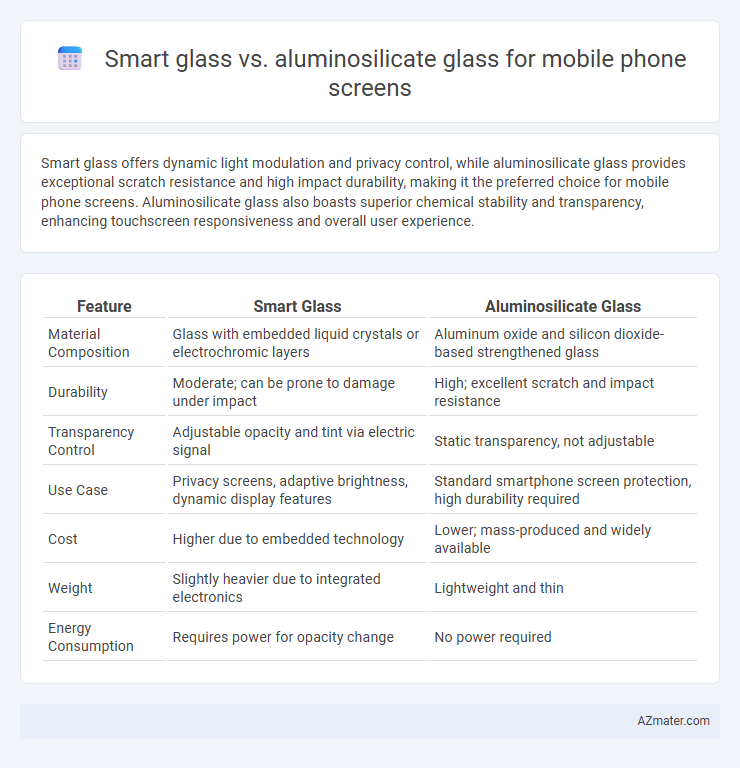Smart glass offers dynamic light modulation and privacy control, while aluminosilicate glass provides exceptional scratch resistance and high impact durability, making it the preferred choice for mobile phone screens. Aluminosilicate glass also boasts superior chemical stability and transparency, enhancing touchscreen responsiveness and overall user experience.
Table of Comparison
| Feature | Smart Glass | Aluminosilicate Glass |
|---|---|---|
| Material Composition | Glass with embedded liquid crystals or electrochromic layers | Aluminum oxide and silicon dioxide-based strengthened glass |
| Durability | Moderate; can be prone to damage under impact | High; excellent scratch and impact resistance |
| Transparency Control | Adjustable opacity and tint via electric signal | Static transparency, not adjustable |
| Use Case | Privacy screens, adaptive brightness, dynamic display features | Standard smartphone screen protection, high durability required |
| Cost | Higher due to embedded technology | Lower; mass-produced and widely available |
| Weight | Slightly heavier due to integrated electronics | Lightweight and thin |
| Energy Consumption | Requires power for opacity change | No power required |
Introduction to Mobile Phone Screen Materials
Smart glass for mobile phone screens integrates dynamic light modulation technology, enhancing user interaction through adjustable transparency and improved privacy features. Aluminosilicate glass, a chemically strengthened material, offers superior scratch resistance and durability, prominently used in flagship smartphones for enhanced screen protection. The choice between smart glass and aluminosilicate glass depends on balancing innovative functionality with robust physical protection to meet evolving consumer demands.
What is Smart Glass?
Smart glass, also known as switchable glass, is a dynamic material that changes its light transmission properties in response to electrical, thermal, or light stimuli, offering privacy control and energy efficiency for mobile phone screens. Unlike aluminosilicate glass, which is valued for its exceptional hardness, scratch resistance, and durability due to its chemical composition, smart glass integrates advanced technologies such as electrochromic or liquid crystal layers to enable features like adjustable transparency and glare reduction. This innovative functionality makes smart glass ideal for customizable display brightness and enhanced user experience, whereas aluminosilicate glass is primarily chosen for structural protection.
What is Aluminosilicate Glass?
Aluminosilicate glass is a type of chemically strengthened glass commonly used in mobile phone screens due to its high resistance to scratches and impacts. It is composed primarily of aluminum oxide and silicon dioxide, providing enhanced durability and thermal stability compared to standard glass. Unlike smart glass, which offers dynamic opacity control, aluminosilicate glass excels in protecting displays from physical damage while maintaining clarity and touch sensitivity.
Durability Comparison: Smart Glass vs Aluminosilicate Glass
Smart glass offers enhanced scratch resistance and impact protection through its electrochromic or photochromic layers, making it durable for everyday mobile use. Aluminosilicate glass, known for its chemical strengthening process, provides superior hardness and resistance to cracking and shattering, often outperforming traditional glass types in drop tests. The durability comparison highlights aluminosilicate glass as a more robust choice for mobile phone screens, whereas smart glass excels in functional versatility and surface protection.
Scratch Resistance: Which Performs Better?
Aluminosilicate glass, commonly used in mobile phone screens like Gorilla Glass, offers superior scratch resistance due to its chemically strengthened composition and high hardness rating on the Mohs scale. Smart glass, despite its advanced functionalities such as opacity control or touch sensitivity, generally lacks the same level of surface hardness, making it more susceptible to scratches in everyday use. Therefore, for durability against scratches, aluminosilicate glass performs better than smart glass in mobile phone applications.
Clarity and Display Quality Differences
Smart glass incorporates electrochromic or liquid crystal technology to adjust opacity, which can sometimes reduce screen clarity and brightness compared to aluminosilicate glass. Aluminosilicate glass, commonly used in mobile phone screens like Gorilla Glass, offers superior scratch resistance and high optical transparency, ensuring sharper and more vibrant display quality. The inherent composition of aluminosilicate glass supports better light transmission and color accuracy, making it a preferred choice for maintaining display clarity under various lighting conditions.
Touch Sensitivity and User Experience
Smart glass enhances touch sensitivity through advanced electrochromic or OLED layers, providing a smoother and more responsive user experience on mobile phone screens. Aluminosilicate glass, known for its high durability and scratch resistance, offers reliable touch accuracy but may lack the adaptive responsiveness found in smart glass technologies. The integration of smart glass in mobile devices leads to improved gesture recognition and dynamic display capabilities, elevating overall user interaction.
Cost Analysis: Smart Glass vs Aluminosilicate Glass
Smart glass for mobile phone screens typically incurs higher manufacturing costs due to advanced materials and technology integration, contrasting with aluminosilicate glass which benefits from mass production and lower raw material expenses. Aluminosilicate glass, especially chemically strengthened variants like Gorilla Glass, offers cost-effective durability and scratch resistance, making it a preferred choice for budget and mid-range devices. Smart glass adds premium pricing justified by features such as dynamic light control and privacy, while aluminosilicate remains the economical option prioritizing protection and clarity.
Environmental Impact and Sustainability
Smart glass for mobile phone screens offers dynamic light control, reducing energy consumption by minimizing screen glare and improving battery efficiency, which supports sustainability efforts. Aluminosilicate glass, prized for its high durability and scratch resistance, extends the lifespan of devices, thereby reducing electronic waste. Selecting between these materials involves balancing energy-saving benefits and longevity to optimize the environmental footprint of mobile phones.
Which Glass is Best for Mobile Phone Screens?
Aluminosilicate glass, commonly known as Gorilla Glass, offers superior hardness and scratch resistance compared to smart glass, making it the preferred choice for mobile phone screens that require durability and impact protection. Smart glass provides dynamic light modulation and privacy features but lacks the robust mechanical strength essential for daily use on smartphones. For optimal screen protection and longevity, aluminosilicate glass remains the best option in mobile phone applications.

Infographic: Smart glass vs Aluminosilicate glass for Mobile phone screen
 azmater.com
azmater.com